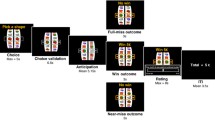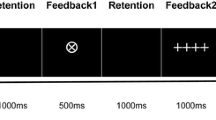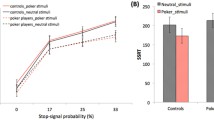Abstract
The near-miss effect in gambling refers to a losing situation that is (or perceived to be) close to a win by the gambler. This effect is one of the many cognitive distortions that can occur during gambling games. The main objective of the present study was to analyze the electrophysiological correlates of the near-miss effect via an event-related potential (ERP) study examining four distinct gambling outcomes: win, full miss, near-miss before the payline, and near-miss after the payline. This study comprised 23 healthy voluntary participants (10 women) with ages ranging between 19 and 34 years (M = 22.5; SD = 3.65). All participants completed the South Oaks Gambling Screen and played a computerized slot machine, programed to induce the near-miss effect and specifically designed for an ERP study. By splitting the near-miss effect in two subtypes (before and after the payline), increased feedback-related negativity (FRN) was found for the near-misses after the payline in comparison to losses and also to near-misses before the payline. Results also indicated an increased P300 amplitude for the near-misses before the payline compared both with losses and with near-misses after the payline. The results suggest that both FRN and P300 present different sensitivities to near-miss subtypes, suggesting a payline effect that is not demonstrated when the data of near-misses before and after the payline are analyzed together. This is the first study to analyze the effect of the near-miss subtype in an ERP study and confirms the findings of previous behavioral studies.





Similar content being viewed by others
References
Alicart, H., Cucurell, D., Mas-Herrero, E., & Marco-Pallarés, J. (2015). Human oscillatory activity in near-miss events. Social Cognitive and Affective Neuroscience,10(10), 1405–1412. https://doi.org/10.1093/scan/nsv033.
Billieux, J., Van der Linden, M., Khazaal, Y., Zullino, D., & Clark, L. (2012). Trait gambling cognitions predict near-miss experiences and persistence in laboratory slot machine gambling. British Journal of Psychology,103(3), 412–427. https://doi.org/10.1111/j.2044-8295.2011.02083.x.
Camerer, C., & Mobbs, D. (2017). Differences in behavior and brain activity during hypothetical and real choices. Trends Cognitive Science,21(1), 46–56. https://doi.org/10.1016/j.tics.2016.11.001.
Clark, L. (2010). Decision-making during gambling: An integration of cognitive and psychobiological approaches. Philosophical Transactions of the Royal Society B: Biological Sciences,365, 319–330. https://doi.org/10.1098/rstb.2009.0147.
Clark, L., Lawrence, A. J., Astley-Jones, F., & Gray, N. (2009). Gambling near-misses enhance motivation to gamble and recruit win-related brain circuitry. Neuron,61(3), 481–490. https://doi.org/10.1016/j.neuron.2008.12.031.
Clark, L., Liu, R., McKavanagh, R., Garrett, A., Dunn, B. D., & Aitken, M. R. F. (2013). Learning and affect following near-miss outcomes in simulated gambling. Journal of Behavioral Decision Making,26(5), 442–450. https://doi.org/10.1002/bdm.1774.
Côté, D., Caron, A., Aubert, J., Desrochers, V., & Ladouceur, R. (2003). Near-wins prolong gambling on a video lottery terminal. Journal of Gambling Studies,19(4), 433–438. https://doi.org/10.1023/A:1026384011003.
Delorme, A., & Makeig, S. (2004). EEGLAB: An open source toolbox for analysis of single-trial EEG dynamics including independent component analysis. Journal of Neuroscience Methods,134, 9–21. https://doi.org/10.1016/j.jneumeth.2003.10.009.
Dillon, R. L., & Tinsley, C. H. (2008). How near-misses influence decision making under risk: A missed opportunity for learning. Management Science,54(8), 1425–1440. https://doi.org/10.1287/mnsc.1080.0869.
Freitas, S., Simões, M. R., Alves, L., & Santana, I. (2011). Montreal Cognitive Assessment (MoCA): Normative study for the Portuguese population. Journal of Clinical and Experimental Neuropsychology,33(9), 989–996. https://doi.org/10.1080/13803395.2011.589374.
Gehring, W. J., & Willoughby, A. R. (2002). The medial frontal cortex and the rapid processing of monetary gains and losses. Science,295(5563), 2279–2282.
Griffiths, M. (1991). Psychobiology of the near-miss in fruit machine gambling. Journal of Psychology,125, 347–357. https://doi.org/10.1080/00223980.1991.10543298.
Griffiths, M. D. (1994). The role of cognitive bias and skill in fruit machine gambling. British Journal of Psychology,85, 351–369. https://doi.org/10.1111/j.2044-8295.1994.tb02529.x.
Griffiths, M. D. (1997). The National Lottery and scratchcards: A psychological perspective. The Psychologist: Bulletin of the British Psychological Society,10, 23–26.
Griffiths, M. D. (1999). Internet addiction: Fact of fiction? The Psychologist: Bulletin of the British Psychological Society.,1999(12), 246–250.
Griffiths, M. D., & Parke, J. (2004). Gambling addiction and the evolution of the “near miss”. Addiction Research & Theory,12(5), 407–411. https://doi.org/10.1080/16066350410001728118.
Habib, R., & Dixon, M. R. (2010). Neurobehavioral evidence for the “near-miss” effect in pathological gamblers. Journal of Experimental Analysis and Behavior,93(3), 313–328. https://doi.org/10.1901/jeab.2010.93-313.
Hajcak, G., Moser, J. S., Holroyd, C. B., & Simons, R. F. (2006). The feedback-related negativity reflects the binary evaluation of good versus bad outcomes. Biological Psychology,71(2), 148–154. https://doi.org/10.1016/j.biopsycho.2005.04.001.
Holroyd, C. B., & Coles, M. G. H. (2002). The neural basis of human error processing: Reinforcement learning, dopamine, and the error-related negativity. Psychological Review,109(4), 679–709. https://doi.org/10.1037/0033-295X.109.4.679.
Kreussels, L., Hewig, J., Kretschmer, N., Hecht, H., Coles, M. G. H., & Miltner, W. H. R. (2013). How bad was it? Differences in the time course of sensitivity to the magnitude of loss in problem gamblers and controls. Behavioural Brain Research,247, 140–145. https://doi.org/10.1016/j.bbr.2013.03.024.
Langer, E. J. (1975). The illusion of control. Journal of Personality and Social Psychology,32(2), 311–328. https://doi.org/10.1037/0022-3514.32.2.311.
Lesieur, H. R., & Blume, S. B. (1987). The South Oaks Gambling Screen (SOGS): A new instrument for the identification of pathological gamblers. American Journal of Psychiatry,144(9), 1184–1188. https://doi.org/10.1176/ajp.144.9.1184.
Lole, L., Gonsalvez, C. J., Barry, R. J., & De Blasio, F. M. (2013). Can event-related potentials serve as neural markers for wins, losses, and near-wins in a gambling task? A principal components analysis. International Journal of Psychophysiology,89(3), 390–398. https://doi.org/10.1016/j.ijpsycho.2013.06.011.
Lopes, H. (2009). Epidemiologia de dependência de jogo a Dinheiro em Portugal. Lisboa: CEA, Universidade Católica Portuguesa.
Lopez-Calderon, J., & Luck, S. J. (2014). ERPLAB: An open-source toolbox for the analysis of event-related potentials. Frontiers in Human Neuroscience,8(213), 1–18.
Luo, Q., Wang, Y., & Qu, C. (2011). The near-miss effect in slot-machine gambling: Modulation of feedback-related negativity by subjective value. NeuroReport,22(18), 989–993. https://doi.org/10.1097/WNR.0b013e32834da8ae.
Markman, K. D., & McMullen, M. N. (2003). A reflection and evaluation model of comparative thinking. Personality and Social Psychology Review, 7, 244–267. https://doi.org/10.1207/S15327957PSPR0703_04.
Mushtaq, F., Stoet, G., Bland, A. R., & Schaefer, A. (2013). Relative changes from prior reward contingencies can constrain brain correlates of outcome monitoring. PLoS ONE,8(6), e66350. https://doi.org/10.1371/journal.pone.0066350.
Nieuwenhuis, S., Holroyd, C. B., & Mol, M. G. (2004). Reinforcement-related brain potentials from medial frontal cortex: Origins and functional significance. Neuroscience and Biobehavioral Review,28(4), 441–448. https://doi.org/10.1016/j.neubiorev.2004.05.003.
Qi, S., Ding, C., Song, Y., & Yang, D. (2011). Neural correlates of near-misses effect in gambling. Neuroscience Letters,493(3), 80–85. https://doi.org/10.1016/j.neulet.2011.01.059.
Reid, R. L. (1986). The psychology of the near miss. Journal of Gambling Behavior,2(1), 32–39. https://doi.org/10.1007/BF01019932.
Sescousse, G., Janssen, L. K., Hashemi, M. M., Timmer, M. H., Geurts, D. E., ter Huurne, N. P., et al. (2016). Amplified striatal responses to near-miss outcomes in pathological gamblers. Neuropsychopharmacology,41(10), 2614–2623. https://doi.org/10.1038/npp.2016.43.
Ulrich, N., & Hewig, J. (2014). A miss is as good as a mile? Processing of near and full outcomes in a gambling paradigm. Psychophysiology,51(9), 819–823. https://doi.org/10.1111/psyp.12232.
Ulrich, N., & Hewig, J. (2018). Electrophysiological correlates of near outcome and outcome sequence processing in problem gamblers and controls. International Journal of Psychophysiology,132(Part B), 379–392. https://doi.org/10.1016/j.ijpsycho.2017.10.011.
Wohl, M. J. A., & Enzle, M. E. (2003). The effects of near wins and near losses on self-perceived personal luck and subsequent gambling behavior. Journal of Experimental Social Psychology,39(2), 184–191. https://doi.org/10.1016/S0022-1031(02)00525-5.
Wu, Y., Sescousse, G., Yu, H., Clark, L., & Li, H. (2018). Cognitive distortions and gambling near-misses in internet gaming disorder: A preliminary study. PLoS ONE,13(1), e0191110. https://doi.org/10.1371/journal.pone.0191110.
Wu, Y., van Dijk, E., & Clark, L. (2015). Near-wins and near-losses in gambling: A behavioral and facial EMG study. Psychophysiology,52(3), 359–466. https://doi.org/10.1111/psyp.12336.
Wu, Y., van Dijk, E., Li, H., Aitken, M., & Clark, L. (2017). On the counterfactual nature of gambling near-misses: An experimental study. Journal of Behavioral Decision Making,30(4), 855–868. https://doi.org/10.1002/bdm.2010.
Xia, J., Wu, D., & Xu, X. (2018). Susceptibility to the gambling near-win effect in optimists versus pessimists: An event-related potential study. Personality and Individual Differences,129, 159–165. https://doi.org/10.1016/j.paid.2018.03.032.
Zhang, Q., & Covey, J. (2014). Past and future implications of near-misses and their emotional consequences. Experimental Psychology,61(2), 118–126.
Acknowledgements
We are grateful to G. Sescousse for his comments and suggestions.
Funding
This work was supported by the COST ACTION 16207—European Network for Problematic Usage of the Internet COST-ITCCG-CA16207-347.
Author information
Authors and Affiliations
Corresponding author
Ethics declarations
Conflict of interest
Part of this work was previously presented at the 5th International Conference on Behavioral Addictions 2018 and Lisbon Addictions 2019. The authors report no conflict of interest with respect to the content of this manuscript.
Research Involving Human Participants and/or Animals
The study was approved by the ethics committee of the research team’s university and followed the Declaration of Helsinki, the European Code of Conduct for Research Integrity, and General Data Protection Regulation recently approved (2016) for EU countries.
Informed Consent
The data were collected in accordance with established ethical standards, namely “informed consent”.
Additional information
Publisher's Note
Springer Nature remains neutral with regard to jurisdictional claims in published maps and institutional affiliations.
Rights and permissions
About this article
Cite this article
Dores, A.R., Rocha, A., Paiva, T. et al. Neurophysiological Correlates of the Near-Miss Effect in Gambling. J Gambl Stud 36, 653–668 (2020). https://doi.org/10.1007/s10899-020-09937-2
Published:
Issue Date:
DOI: https://doi.org/10.1007/s10899-020-09937-2




